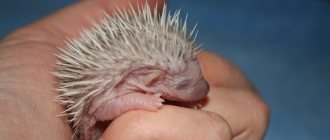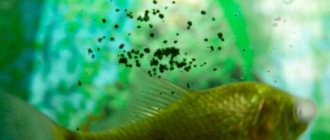Description and features
The appearance and behavior of the dwarf tetradon (lat. Carinotetraodon travancoricus) makes it a very attractive and sought-after fish. The body is pear-shaped with a transition to a large head. It is quite dense with small spines that are not visible when the fish is calm, but if it is scared or worried about something, the fish
inflates like a ball and spikes become a weapon and protection.
However, such frequent transformation of it negatively affects health and it is impossible to specifically frighten the tetradon.
At the same time, the size of the dwarf tetradon reaches 2.5 cm. The anal fin is poorly expressed, the others are expressed by soft rays. Relative to the body, the fins look miniature and very mobile, like the wings of a hummingbird
.
The fish has large, expressive eyes that amaze with their mobility, but if the tetradon is looking at something, they will stand almost motionless.
Fish mouth
somewhat reminiscent of a bird's beak, with fused premaxillary and jaw bones, however, the fish is predatory and also has 4 plates of teeth, located two at the bottom and at the top.
Distinguishing a male from a female is a very difficult task. Sexually mature male tetradons are usually brighter in color than female fish of the same age and have a dark line along the belly. Tetradons come in a variety of colors, some of which form the names of the varieties of these fish.
Varieties of Tetraodon
Depending on the type of puffer fish, they are placed in marine species or river aquariums. Here are just a few of the varieties of tetraodon.
African tetraodons
These are inhabitants of the natural habitat of the lower reaches of the African Congo. Although they are freshwater creatures, they also love brackish water. The length of the fish is about 10 cm, the body color is from light to dark brown with yellowish spots and streaks and the belly is the same color.
Eight tetraodons
Two-eyed or curly fish are inhabitants of Southeast Asia, the Sunda Islands. The maximum body size is up to 10 cm.
The main color background is dark, brown, almost black. But the color of each fish is individual due to the yellow wide or narrow stripes that dot the body. The belly is white, becomes spotted with age and becomes slightly darker.
When viewed from above, two black spots stand out at the base of the dorsal fin closer to the tail. They are bordered in yellow and very much resemble eyes, which is why the variety got its second name.
The brightness of the color is not lost even in older individuals. Females are much larger than males. Young specimens are quite calm, but with age they become quite aggressive and actively guard their territory.
They love brackish water.
Green Tetraodons
Tetraodon nigroviridis is one of the most beloved species by aquarists.
Indeed, Nigroviridis is very beautiful, but this predator is quite difficult to keep.
This Asian and African subtropical underwater inhabitant has an amazing greenish-yellowish body color with large dark spots. Can grow up to 17 cm in length.
These fish are born in the wild during the rainy season and are therefore comfortable with fresh water. But for adults it is better to have a brackish pond.
Dogfish are predators, they are aggressive and toxic. It is better to keep them in a species aquarium. They are distinguished by high intelligence for underwater inhabitants, they recognize the owner and begin to happily fuss when he approaches the tank.
The spotted tetraodon constantly grows teeth; it needs to grind them down on hard food. Small snails are ideal for this.
It is difficult to breed in an artificial environment, but there are known cases of obtaining from a couple to two hundred eggs during one spawning.
Dwarf tetraodons
These fish are also called yellow for their characteristic coloring - a golden shiny body of short length (usually 2.5-3 cm, but some specimens grow up to 5-6 cm) with rare greenish or brownish spots. In nature, they live in the coastal waters of the Indian Ocean, Malaysia, Indonesia, and Indochina.
Males are noticeably brighter than females; their abdomen has a reddish tint during mating games. More peaceful than other species, but still these freshwater fish are predators.
Capable of breeding in an aquarium.
Tetraodons Kutkutya
Tetraodon cutcutia grows to 15-17 cm in length. Prefers salted water. Males are brighter than females, the color is yellowish or greenish with rare spots. This is a dangerous and poisonous predator. It is better to keep it in a species aquarium.
Tetraodons Fahaka
These are large ray-finned fish of the pufferfish family. They grow up to 40-45 cm, suitable for aquariums or special species aquariums.
Nile tetraodon prefers bottom habitat in fresh or brackish waters of rivers and lakes in Africa - the Nile, Niger, Volta, Gambi, Lake Turkana, Chad, Nasser Reservoir.
Tetraodon Mbu
This is the largest bottom-dwelling fish of the pufferfish order, about 75 cm long. It lives in fresh and brackish waters of Africa, in Lake Tanganyika. A very rare inhabitant of aquariums and large demonstration aquariums. Mbu meat is poisonous; this species has no commercial significance.
Content
Taking into account the characteristics of tetradons, the following conditions can be distinguished for their comfortable life in an aquarium: Availability of clean fresh water. Individuals do not tolerate even slightly salted water; this can cause them to quickly die. On average, 5-7 liters of water is enough for one tetradon to live, sufficiently balanced in the amount of nitrates and ammonia (fish are sensitive to them). Maintaining sufficient temperature. Since they come from India, to keep them the water temperature must be kept constantly warm - about 23-26 degrees. Aquarium water must be clean.
Tetradons can easily eat only the required amount of food and leave the leftovers to rot. It is recommended to use a filter, and do not forget to fill it with clean water (about 20% of the total mass per week). Arrange the “interior” of the aquarium. These fish love to hide in plants and swim among snags, so you should take care of their presence in advance. In general, we can say that tetradons are quite unpretentious fish, they are able to adapt, you just need to take into account their unique characteristics. They prefer balance, so when it comes to arranging their home, you just need to avoid extremes. You should also remember that they are far from expert swimmers; it is not recommended to create a strong current in the water (do not use strong filters).
Nutrition
The biggest difficulty in keeping dwarf tetradons is proper feeding. No matter what the pet store tells you, fish don't touch pellets or flakes. In their natural habitat, they feed on invertebrates, snails and small insects. Therefore, at home you will have to provide them with the same diet, otherwise they will starve.
The best food options are squid (frozen) and small snails (melania, frieza). Tetradons will not refuse bloodworms, artemia and daphnia. Although they still prefer live food, which they can hunt for.
Whatever food you choose, the basis of your fish’s diet should be snails. They not only get enough of them, but also grind their teeth on their shells. This food will not be enough for a long time, so it is better to grow arthropods in another container and plant them in the aquarium with the tetradons as needed. It should be taken into account that fish will ignore large snails.
It is recommended to feed pets twice a day, giving food in small portions. Fish are prone to overeating, so there is no need to be overzealous.
Feeding
Tetraodons must receive sufficient amounts of protein food. These can be snails, small shrimp, bloodworms, daphnia, tubifex, worms, crustaceans, and fry.
Sometimes you can give special dry food for predatory fish species. But it should be remembered that tetraodon teeth need tough and hard food, they must be regularly ground down.
If you purchase young tetraodons at the same time as juvenile zebrafish, rasboras, rainbowfish, and discus fish, you can try placing them in one large aquarium. But if the neighbors’ fins begin to suffer, then it is better to stop this experiment and resettle the dog fish.
Compatibility
The dwarf tetradon is a very quarrelsome neighbor that will not leave other inhabitants of the aquarium alone. Therefore, it is better to keep such fish separately, especially since they do not need a large displacement. Tetradons are very territorial, and in the fight for their space they can be extremely aggressive. This often results in the death of their rivals, even if they are larger. Among those with whom pufferfish predators can exist in peace for some time: otocinclus and shrimp.
A fairly large flock of tetradons can live in one aquarium, but only if there is a sufficient amount of food and shelter.
Interesting Facts
- The dwarf tetradon is a smart fish. When people appear, he sticks to the glass, protruding his eyes; begs for food, “dancing” near the glass. He quickly begins to understand who brings him food and recognizes his breadwinner in any crowd.
- At the slightest stress, dwarf tetradons triple in size, turning into a ball. They know how to inflate their tummy with air and water.
- Before attacking the chosen prey, these predators freeze for a long time in one position, closely examining their target. They attack only with good aim.
- When getting ready to sleep, the tetradon lies on its side and curls its tail, like a domestic cat.
- Red and orange colors irritate these fish, causing them to attack. If there are inhabitants in the aquarium painted in these colors, tetradons will never leave them alone.
- This little one tries to eat even large snails, biting off pieces of them. That is, it acts on the principle “Whatever I don’t eat, I’ll bite it.”
- During the day, fish rarely show aggression, going out to hunt at night. Most often they attack fish living in the lower layer of the aquarium.
- Tetradons swim using their pectoral fins and their tail tucked. At the same time, it seems that he is not there at all. They straighten their tail part only when faced with their own kind.
Reproduction
Dwarf tetradons form a short-term pair of a male and a female and arrange preliminary games. The male, having fluffed out his dorsal and ventral crests, circles around the female. If she reciprocates, she will follow the male to his designated spawning location, lay her eggs and swim away. The male will remain to fertilize her. This procedure can be repeated several times. The male usually chooses a spawning site in dense thickets of plants or in thickets of aquarium mosses. The area with the laid eggs will be such that the male can protect it from other annoying males.
The male dwarf tetradon will guard the territory with eggs and ventilate it until the young hatch. Females do not take any part in caring for eggs and raising offspring. The fry are born large enough for such a small fish, and are immediately able to take newly hatched brine shrimp, although not all fry are born so large. Hobbyists often manage to breed tetradons at home.
Keeping the fry
Tetradon caviar is transparent, up to approximately a millimeter in size. On average, one female produces about a hundred eggs. Parents are not sentimental and may well eat their future offspring.
Experienced aquarists collect fertilized eggs using a pipette or other devices and send them to safer conditions. In this case, milky white eggs are rejected; most likely they are unfertilized or diseased. A small cage with water from a community aquarium will be enough for the fry to appear. Temperature and other requirements are the same as described earlier, a special filter is needed, without the risk of absorbing eggs or fry. Algae and moss from the parent site will also be useful.
You should wait about a week and larvae will appear from the eggs - future tetradons. For the first three days they do not need feeding from reserves from the yolk sac. Having settled in a new place, the fry more and more resemble brave little ones - tetradons; fine food such as ciliates and microworms will ensure their further development, and after a month, the little ones will try “adult” food for the first time - frozen bloodworms.
After two months, they reach a length of one centimeter and can themselves hunt small inhabitants of their environment.
Breeding
Dwarf tetradons reproduce well in captivity, especially when optimal conditions are created for this. To get a new generation of these babies, it is necessary to place the mating couple, the entire flock, or create a kind of harem with the participation of one “master” and several “wives” in the spawning area. The latter option is preferable for many reasons.
- In this way, you will get much more fry, since one female releases only 7–10 eggs.
- The male will be busy with several girlfriends at once and will not be able to drive them half to death.
- There will be no fights between several males for possession of a female. Small but cocky fish fight until one of them dies.
You should first place a variety of small or thin-leaved plants in the spawning aquarium. Mosses, ambulia, and cabomba are most suitable. The water should be very warm, at least 25°.
Having relocated the future parents, they begin intensive feeding. Before spawning, it is recommended to feed the fish only with live food and snails. The male signals his readiness to breed by changing his color to darker and brighter. At this time, he begins to rush after the females, biting their sides. The running ends in a thicket of plants, where the couple begins to reproduce. The female releases eggs, and the male releases milk.
Sex differences
The fry look exactly the same, but the adult fish can be distinguished. Males have a dark stripe along the abdomen; females lack it. But “girls” have a slightly fuller and rounder tummy.
Getting offspring
Small transparent eggs do not have an adhesive substance, so they simply fall onto the ground or plants. To prevent them from getting into the teeth of their own parents, they need to be moved to a separate aquarium. The easiest way to do this is with a pipette or tweezers. Opaque whitish caviar must be disposed of - these are usually contaminated with fungi and are infertile.
ADVICE! If you cannot see the eggs, walk around the spawning area with a small hose. He is guaranteed to collect the lost items.
In the aquarium for fry, it is necessary to create conditions that are optimal for adult tetradons. True, not just any filter will suit them! You cannot equip the container with a device that can suck in small fish.
The fry emerge from the eggs in 3–5 days and first feed from the yolk sacs. They begin to be given food on the third or fourth day. In the first week, you can feed only very small organisms such as ciliates and microworms. Then the fry are transferred to Artemia nauplii for about a month. For older fish, the diet is enriched with small snails and frozen food.
Be sure to sort the fry to prevent cannibalism. More developed individuals will gladly eat weak and small relatives.
Diseases
This small predator gets sick very rarely. Most often, the cause of illness is improper care and poor living conditions. Poisoning with ammonia compounds. The gills suffer the most; they become inflamed, turn red and increase in size. The fish breathes with difficulty and prefers to stay close to the surface. The problem can be eliminated by installing a good filter, frequent water changes, siphoning the bottom and adding zeolite to the water - a drug that absorbs excess ammonia. Nitrate poisoning. A sick fish first becomes agitated, moves erratically, and reacts to the slightest stimuli.
Then convulsions develop, the tetradon goes to the bottom. All his fins and gills are spread out, his mouth is open. Sick fish should be immediately placed in a temporary aquarium with clean water, and in a permanent aquarium, thoroughly siphon the bottom, replace half of the water with fresh water, rinse the filter and add substances that neutralize nitrates. Dropsy. The tetradon's abdomen is strongly inflated, and its scales are raised. The color loses intensity and brightness. Most likely, your tetradon is lacking food. Increase the diet, improve its quality, switch the fish only to live food and be sure to feed snails. Lifespan If kept in good conditions, the tetradon can live for about 5 years.











